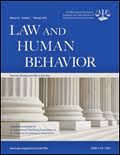 The Fordham Risk Screening Tool may be able to identify patients in need of further violence risk assessment and screen out patients who would receive low risk ratings. This is the bottom line of a recently published article in Law and Human Behavior. Below is a summary of the research and findings as well as a translation of this research into practice.
The Fordham Risk Screening Tool may be able to identify patients in need of further violence risk assessment and screen out patients who would receive low risk ratings. This is the bottom line of a recently published article in Law and Human Behavior. Below is a summary of the research and findings as well as a translation of this research into practice.

Featured Article | Law and Human Behavior | 2017, Vol. 41, No. 4, 325-332
Determining When to Conduct a Violence Risk Assessment: Development and Initial Validation of the Fordham Risk Screening Tool (FRST)
Authors
Barry Rosenfeld Fordham University
Melodie Foellmi Fordham University
Ali Khadivi Albert Einstein College of Medicine
Charity Wijetunga Fordham University
Jacqueline Howe Fordham University
Alicia Nijdam-Jones Fordham University
Shana Grover New School for Social Research, New York, New York
Merrill Rotter Albert Einstein College of Medicine
Abstract
Techniques to assess violence risk are increasingly common, but no systematic approach exists to help clinicians decide which psychiatric patients are most in need of a violence risk assessment. The Fordham Risk Screening Tool (FRST) was designed to fill this void, providing a structured, systematic approach to screening psychiatric patients and determining the need for further, more thorough violence risk assessment. The FRST was administered to a sample of 210 consecutive admissions to the civil psychiatric units of an urban medical center, 159 of whom were subsequently evaluated using the Historical Clinical Risk Management-20, version 3, to determine violence risk. The FRST showed a high degree of sensitivity (93%) in identifying patients subsequently deemed to be at high risk for violence (based on the Case Prioritization risk rating). The FRST also identified all of the patients (100%) rated high in potential for severe violence (based on the Serious Physical Harm Historical Clinical Risk Management-20, version 3, summary risk rating). Sensitivity was more modest when individuals rated as moderate risk were included as the criterion (rather than only those identified as high risk). Specificity was also moderate, screening out approximately half of all participants as not needing further risk assessment. A systematic approach to risk screening is clearly needed to prioritize psychiatric admissions for thorough risk assessment, and the FRST appears to be a potentially valuable step in that process.
Keywords
violence, risk assessment, screening, triage, psychiatric patients
Summary of the Research
“The use of structured instruments that can help guide clinical decisions about violence risk is well established. In some settings, a thorough violence risk assessment is a required element of the clinical or forensic evaluation (e.g., determining whether a patient acquitted not guilty by reason of insanity if suitable for release into the community). In many settings; however, the decision as to whether a thorough evaluation of violence risk is necessary is made on a case-by-case basis. Unfortunately, little guidance exists as to how clinicians or administrators should make the decision to utilize a risk assessment instrument. Although tools to assess violence risk are readily available, a thorough violence risk assessment requires considerable time and resources, both of which are in short supply in most clinical settings. [It has been] estimated that a thorough violence risk assessment requires approximately 15 hours for a trained evaluator, far exceeding the resources available in most clinical settings (although a less thorough assessment can certainly be done more quickly). Hence, institutions are likely forced to triage admissions to determine where to focus their resources. To date, the process of determining when or whether to conduct a violence risk assessment has been largely unstructured, untested, and inconsistent, with considerable potential for error” (p. 325).
“Several published instruments have been described as violence screening tools; however, these instruments are more accurately characterized as brief measures that gauge the likelihood of future violence. Instruments such as the V-RISK-10, the Clinically Feasible Iterative Classification Tree, and the Violence Screening Checklist do not provide a true screening function, which is typically conceptualized as casting a broad net to identify a subgroup of individuals who require further examination. Rather, these instruments are intended to efficiently differentiate higher and lower risk individuals, a goal more consistent with triage—a rapid approach designed to determine how to prioritize assessment or intervention resources. In the context of violence risk, a triage approach would determine which patients need a violence risk assessment most urgently. A violence risk-screening instrument, on the other hand, would identify those patients who need further evaluation—that is, a comprehensive violence risk assessment. Hence, screening tools are most effective when the have a very high degree of sensitivity (i.e., identifying all or most of the individuals with a designated condition) and a meaningful level of specificity (i.e., to eliminate a sufficient number of cases as not needing further attention) or the reverse (near perfect specificity and an adequate level of positive predictive accuracy). Other indices of classification accuracy, such as the tool’s positive predictive value, are less useful in the context of screening because they are unduly influenced by the base rate of the condition under investigation” (p. 326).
“In response to the need for a systematic approach to violence risk screening and following the recommendations of the New York State/New York City Mental Health-Criminal Justice Panel’s report, our research team created the Fordham Risk Screening Tool [FRST]. Drawing on face-valid content, the FRST is a flow chart designed to help clinicians decide which patients need a thorough violence risk assessment” (p. 326).
“[T]he FRST is an algorithm intended to determine the need for a comprehensive violence risk assessment in psychiatric inpatients. Based on face-valid variables that should raise concerns about the possibility of violence, the FRST classifies an individual as needing a violence risk assessment when the patient displays recent and severe violent behavior, threats or ideation. Recent is operationalized as the preceding 6 months, and severe reflects behavior, threats, or ideation that has or could plausibly result in physical harm that requires medical attention. In addition to the historical FRST risk factors that form the basis of the core algorithm, the tool also elicits clinician ratings of three current risk factors that should be considered: agitation/hostility, paranoia or threat/control override symptoms, and refusal of medication” (p. 327).
“Given that the goal of screening is to identify cases in which a condition might be present (in this case, high risk of future violence), the criterion that the FRST is designed to predict is a high risk rating on a well-validated risk assessment instrument. This criterion is ideal for a screening instrument, given that a wide range of intervening variables can impact whether an individual actually engages in violence (e.g., intervention, incapacitation). Indeed, one result of a thorough risk assessment is the identification and implementation of effective risk-management strategies, hopefully resulting in a lower risk of violence in the future. It follows that individuals deemed to represent a high risk of future violence should receive aggressive interventions intended to reduce the likelihood of actual violence, whereas individuals deemed to be low risk may require little or no further intervention” (p. 326).
“Study participants were a nonoverlapping, consecutive sample of psychiatric patients (N 210) admitted to a large, private, nonprofit hospital in New York City. Most participants were brought to the hospital by the police (n = 34, 16.0%) or emergency medical personnel (n = 97, 45.5%), and the vast majority of patients were involuntarily hospitalized (n = 158, 75.2%)… The sample included 120 males (57.1%) and 90 females (42.9%), ranging in age from 18 to 68 years old (M 37.5, SD 14.2). Half of the participants were African American (n = 108, 53.5%), whereas 62 (30.7%) identified as Hispanic and 17 (8.4%) as Caucasian, non-Hispanic; 15 individuals (7.4%) were classified as an other racial/ethnic group, and these data were missing for eight individuals (3.8%)” (p. 327).
“Following admission to one of the study institution’s three psychiatric units, patients were interviewed using the FRST by a study research assistant (all of whom were doctoral students in clinical psychology). Approximately 1 week after admission, each patient was also interviewed by a second graduate student using a structured interview developed for this study to rate the HCR-20V3 and generate risk estimates” (p. 327).
“The results of this study provide preliminary support for the FRST, demonstrating a very high degree of sensitivity in identifying high-risk individuals. Moreover, the FRST identified more than 80% of those individuals rated as moderate or high risk. Simultaneously, the screening process guided by the FRST eliminated approximately half of all patients from needing further evaluation regarding risk of violence. Indeed, even when the criterion was expanded to include individuals identified as posing a moderate risk of violence on the summary risk ratings, the FRST retained sensitivity rates of approximately 80%. Thus, this study provides strong support for the FRST in differentiating those psychiatric patients who require a more comprehensive risk assessment from those who do not” (p. 329).
Translating Research into Practice
“Few issues generate as much concern in mental health settings as the potential for violence. Many expect that mental health professionals will be able to identify those individuals who represent a serious risk of violence and thereby prevent or minimize the occurrence of violence. Although important advances have occurred in the field of violence risk assessment, the time and resources needed to adequately assess whether an individual poses a significant risk of violence are substantial. Given this dilemma, there is a clear need for an effective method of screening psychiatric patients to determine where to apply those scarce resources. The FRST is intended to provide this function by utilizing a structured, reliable, and objective approach to identifying those psychiatric patients that are most likely to require a further, more comprehensive assessment” (p. 328-329).
“Given the time and resources needed to conduct a violence risk assessment, it may be impractical to evaluate even half of all admissions to a psychiatric facility… administrators and clinicians will need to determine whether a tool such as the FRST is appropriate for their setting. These decisions involve weighing the risks and benefits of not only sensitivity and specificity rates but also the cost of maintaining the status quo… Of course, the FRST need not (and should not) necessarily be considered a final judgment; decisions not to conduct further assessment can always be revisited if additional information or behavioral changes heightened concerns about possible violence” (p. 329).
Other Interesting Tidbits for Researchers and Clinicians
“Obviously, determining an adequate level of sensitivity for a screening instrument is far more complex than simply generating seemingly strong classification accuracy. Even a single false-negative result (i.e., the failure to identify an individual who poses a high risk of violence) could result in severe consequences, both for the individuals who are the target of the violence as well as the clinicians and administrative staff who might be held responsible for failing to prevent the harm. Ideally, a risk-screening instrument would have perfect sensitivity, but that goal is likely impossible unless virtually all individuals are screened in. Indeed, the results of this study are perhaps as close to perfect accuracy as could be hoped for, albeit not eliminating as many false-positive cases as might be desired. Nevertheless, continued research is necessary to identify additional indicators that might help identify those high-risk individuals who are missed by the FRST” (p. 329).
Join the Discussion
As always, please join the discussion below if you have thoughts or comments to add!







